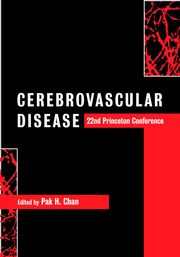Book contents
- Frontmatter
- Contents
- List of contributors
- Preface
- Acknowledgments
- Part I Special lectures
- Part II Oxidative stress
- Part III Apoptosis
- Part IV Hot topics
- Part V Hemorrhage, edema and secondary injury
- Part VI Inflammation
- Part VII Gene transfer and therapy
- Part VIII Neurogenesis and plasticity
- 25 Transplantation of neural stem cells: cellular and gene therapy in pediatric hypoxic–ischemic brain injury
- 26 Neural plasticity after cerebral ischemia
- 27 Environmental effects on recovery after stroke
- Part IX Magnetic resonance imaging in clinical stroke
- Part X Risk factors, clinical trials and new therapeutic horizons
- Index
- Plate section
25 - Transplantation of neural stem cells: cellular and gene therapy in pediatric hypoxic–ischemic brain injury
from Part VIII - Neurogenesis and plasticity
Published online by Cambridge University Press: 02 November 2009
- Frontmatter
- Contents
- List of contributors
- Preface
- Acknowledgments
- Part I Special lectures
- Part II Oxidative stress
- Part III Apoptosis
- Part IV Hot topics
- Part V Hemorrhage, edema and secondary injury
- Part VI Inflammation
- Part VII Gene transfer and therapy
- Part VIII Neurogenesis and plasticity
- 25 Transplantation of neural stem cells: cellular and gene therapy in pediatric hypoxic–ischemic brain injury
- 26 Neural plasticity after cerebral ischemia
- 27 Environmental effects on recovery after stroke
- Part IX Magnetic resonance imaging in clinical stroke
- Part X Risk factors, clinical trials and new therapeutic horizons
- Index
- Plate section
Summary
Introduction
Stroke is the third most common cause of death, and being among the most common causes of severe disability in adults of developed countries accounts for a large proportion of health care costs. Its impact on individual patients, their families and society as a whole is immense. Approximately 200 per 100000 adults per year will have their first stroke. Because the incidence of stroke increases with age, the absolute number of patients with stroke is likely to increase even more, given that the population of aged adults is also increasing. However, brain injury from ischemia does not affect only the adult population. It is a major cause of mortality and severe neurodevelopmental disability (cerebral palsy, mental retardation, epilepsy and learning disabilities) in the pediatric – especially the newborn – population. The drain on resources to support such children (often long into adulthood or an entire lifetime) is also quite significant. Although the etiologies for ischemic brain injury in adults and children may differ, much of the pathophysiology underlying neural cell death and dysfunction is quite similar. In the case of newborn infants, despite advances in technology allowing better obstetric and neonatal care and a deeper understanding of the pathophysiology of perinatal asphyxia, the incidence of hypoxic–ischemic encephalopathy (HIE) in neonates has remained essentially unchanged over the last few decades.
- Type
- Chapter
- Information
- Cerebrovascular Disease22nd Princeton Conference, pp. 299 - 316Publisher: Cambridge University PressPrint publication year: 2002



